Explore Ghanzi - Botswana Travel, Africa
Located in the western part of Botswana, Ghanzi offers a unique travel experience that immerses visitors in the beauty of the Kalahari Desert. Known as the "Gateway to the Kalahari," this charming town is a must-visit for adventure seekers and cultural explorers. Its proximity to both stunning wilderness and rich indigenous heritage makes Ghanzi a perfect destination for those looking to experience both nature and culture in one trip. Whether you're interested in wildlife safaris, bushcraft with the San people, or relaxing under the vast, starry sky, Ghanzi is a destination that offers unforgettable memories.
Population: Approximately 100,000 in 2022.
Economy: Ghanzi’s economy is driven by agriculture, livestock farming, and tourism. The town serves as a regional trade hub, supporting local businesses and contributing to the broader economy of Botswana.
Landmarks: Famous for the Kuru Art Project, D'Kar Museum, and the Kalahari Desert Safaris.Located in the western part of Botswana, Ghanzi offers a unique travel experience that immerses visitors in the beauty of the Kalahari Desert. Known as the "Gateway to the Kalahari," this charming town is a must-visit for adventure seekers and cultural explorers. Its proximity to both stunning wilderness and rich indigenous heritage makes Ghanzi a perfect destination for those looking to experience both nature and culture in one trip. Whether you're interested in wildlife safaris, bushcraft with the San people, or relaxing under the vast, starry sky, Ghanzi is a destination that offers unforgettable memories.
Population: Approximately 21,000 in 2021.
Economy: Ghanzi’s economy is driven by agriculture, livestock farming, and tourism. The town serves as a regional trade hub, supporting local businesses and contributing to the broader economy of Botswana.
Landmarks: Famous for the Kuru Art Project, D'Kar Museum, and the Kalahari Desert Safaris.
Botswana
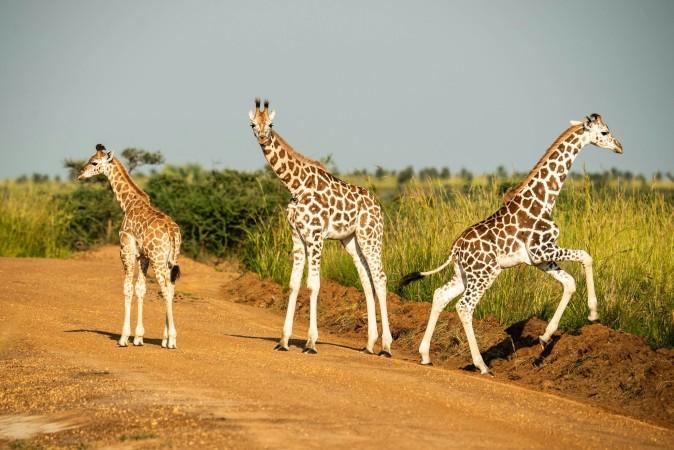
Overview of Ghanzi
History & Cultural Influence
Ghanzi has a deep connection to Botswana's history and is particularly known for being the home of the San (Bushmen), one of the world's oldest continuous cultures. For thousands of years, the San people have lived in harmony with the harsh desert landscape, mastering survival skills that tourists can now experience firsthand. Over time, Ghanzi evolved from a small settlement to a significant town due to its role in cattle ranching and the influence of Bantu tribes that migrated into the region. Though modern developments have come to Ghanzi, the town has maintained much of its traditional charm.
Interaction with The Locals
Ghanzi's population is primarily made up of San (Bushmen), Bantu-speaking groups, and Afrikaner farmers. The San people, known for their deep connection to the Kalahari Desert, are the oldest inhabitants, while the Bantu groups and Afrikaners settled later. The locals are known for their resilience, hospitality, and commitment to preserving their cultural heritage despite modern influences. Visitors can engage with diverse communities, gaining insight into traditional ways of life that continue to thrive in this unique part of Botswana.
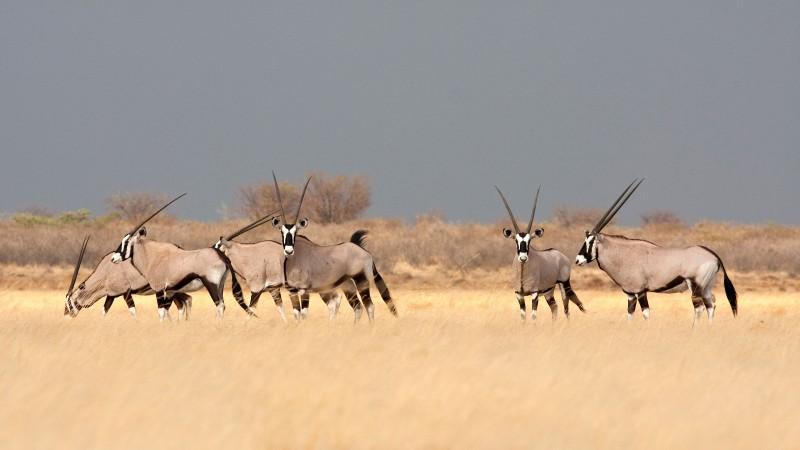
Ghanzi Savannah - © Peapix
Top Attractions in Ghanzi
Kuru Art Project
The Kuru Art Project is a must-see for anyone visiting Ghanzi. This unique initiative brings together local San artists who create vibrant paintings and crafts that reflect their deep connection to the land and their rich cultural heritage. The artworks you find here aren’t just beautiful souvenirs—they’re pieces of San's storytelling tradition, capturing the essence of the Kalahari Desert. Purchasing these pieces supports the artists and helps preserve their craft.
D'Kar Museum
Located in the nearby D’Kar Village, the D’Kar Museum offers fascinating insights into the history and daily life of the San people. Exhibits cover a range of topics, from their traditional ways of living to their relationship with the environment. It’s an excellent starting point for those wanting to understand the complex and resilient culture of the indigenous communities that have inhabited this area for thousands of years.
Kalahari Desert Safaris
Ghanzi serves as a gateway to the Kalahari Desert, where adventure awaits. Embark on guided safaris that will take you deep into the desert, where you can encounter unique wildlife like gemsbok, kudu, and the playful meerkat. Whether you’re interested in day trips or multi-day excursions, the vastness of the Kalahari offers unparalleled opportunities for wildlife viewing, desert treks, and stargazing under one of the clearest night skies in the world.
Ghanzi Craft Market
For those who love to shop while traveling, the Ghanzi Craft Market is the perfect place to find handmade jewelry, traditional clothing, and crafts. Everything is made by local artisans, and each item tells a story of the region’s cultural richness. Whether you’re looking for souvenirs or a meaningful gift, this market offers a wide selection of items that support the local economy and artisans.
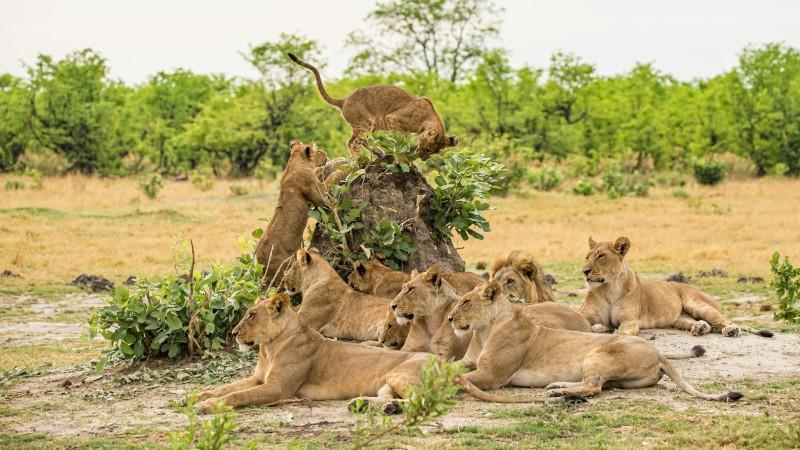
Lion pride in Kalahari Desert Safaris - © Birger Strahl
Must-Try Dishes in Ghanzi
Ghanzi offers a rich array of traditional Botswana cuisine, reflecting the region's Kalahari Desert roots and the culinary traditions of the San people.
- Seswaa: One of Botswana’s national dishes, Seswaa is a savory stew made from slow-cooked beef, goat, or lamb, seasoned with simple ingredients. The meat is shredded and typically served with a maize meal, known as pap, or sorghum porridge. This dish is a hearty and flavorful representation of local food traditions.
- Morogo: For a traditional vegetarian option, Morogo is a dish made from wild spinach or other leafy greens that are foraged from the desert. It's cooked with onions and tomatoes and often served with pap. This dish highlights the locals' ability to make the most of the available natural resources.
- Kalahari Truffle: Known locally as N'abbas, the Kalahari truffle is a desert delicacy that appears after the rainy season. With its earthy, nutty flavor, it is often enjoyed roasted or as part of other traditional dishes. The truffle is a rare treat and a favorite among locals and visitors alike.
- Biltong: A popular snack throughout Southern Africa, Biltong in Ghanzi is typically made from beef or game meat like kudu or springbok. The meat is cured and dried, resulting in a savory, protein-packed treat that’s perfect for on-the-go adventurers.
- Vetkoek: A favorite street food, Vetkoek is a deep-fried dough bread that can be served plain or filled with minced meat. Crispy on the outside and soft on the inside, it’s a great snack or accompaniment to a hearty meal.
- Bogobe Jwa Lerotse:This traditional dish features a mixture of sorghum porridge with lerotse melon, a type of wild melon native to the Kalahari Desert. The melon gives the dish a slightly sweet and refreshing flavor, making it a perfect complement to savory meats.

Seswaa - © Cosmo Appliances
Festivals & Local Celebrations
Kuru Dance Festival
One of the most anticipated cultural events in Ghanzi, the Kuru Dance Festival is held annually in August at the D’Kar village. This multi-day festival brings together different San communities from Botswana and neighboring countries, celebrating their shared cultural heritage through traditional dance and song. The festival is a unique opportunity for visitors to witness the healing and trance dances of the San, which are an integral part of their spiritual practices. Participants, often dressed in traditional attire, perform around the fire, telling stories of their history, environment, and way of life. Visitors are encouraged to engage with the performers and learn more about the San people’s deep connection to the Kalahari Desert.
Botswana Day
Botswana Day, celebrated on September 30th, marks Botswana’s independence from British rule in 1966. In Ghanzi, the celebration is a colorful event filled with national pride. The day begins with official parades, flag-raising ceremonies, and speeches, followed by a lively display of traditional Tswana dances, choir performances, and cultural exhibitions. Local schools and communities come together to perform, creating a festive atmosphere. Visitors can partake in communal meals, where they can enjoy local dishes such as Seswaa and Morogo while interacting with residents. The evening often concludes with live music performances, fireworks, and a sense of unity among the people of Botswana.
D’Kar Arts and Culture Festival
This annual festival celebrates the San people’s artistic and cultural contributions. Held at the Kuru Art Centre in the village of D’Kar, the event includes exhibitions of San art, including paintings, beadwork, and crafts. Visitors can meet local artisans, watch them create their pieces, and purchase unique artworks directly from the creators. The festival also includes storytelling sessions and traditional dance performances, offering a deeper understanding of San folklore and history. The D’Kar Arts and Culture Festival is not only a celebration of the San’s artistic talent but also an opportunity to support local artists and preserve their cultural heritage.
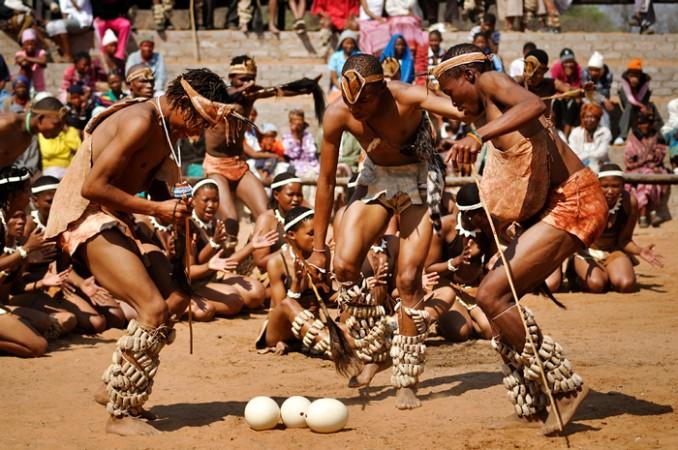
Kuru Dance Festival - © Africa Geographic
What to Do in Ghanzi
- Bush Walks with the San: Join a guided bush walk led by local San guides to learn about their traditional survival techniques. Discover how they track animals, find water in the desert, and use medicinal plants to thrive in the harsh Kalahari environment.
- Wildlife Safaris: Explore the Kalahari Desert on a thrilling wildlife safari. Spot native species such as gemsbok, kudu, and meerkats, or take a night safari to witness the desert’s nocturnal creatures and stunning starry skies.
- Cultural Workshops: Take part in a San cultural workshop where you can learn about traditional crafts, such as bead-making and leatherwork, or participate in a San storytelling session. These workshops provide deep insights into the community’s heritage and customs.
- Stargazing in Ghanzi: Thanks to its clear, unpolluted skies, Ghanzi is a top destination for stargazing. With minimal light interference, the desert offers spectacular views of the Milky Way and other constellations, making it a haven for astronomy enthusiasts.
Shopping in Ghanzi
- San Crafts and Souvenirs: Visit the Ghanzi Craft Market, where artisans from the local San community sell handmade jewelry, clothing, and traditional items crafted from natural materials. These pieces not only make great souvenirs but also support local livelihoods.
- Kuru Art Centre: At the Kuru Art Centre, you’ll find an array of art created by San artists. Their paintings, sculptures, and crafts often depict scenes from daily life and the surrounding desert, capturing the essence of Ghanzi's culture. Purchasing a piece of art here allows you to take home a unique memento while supporting the local community.
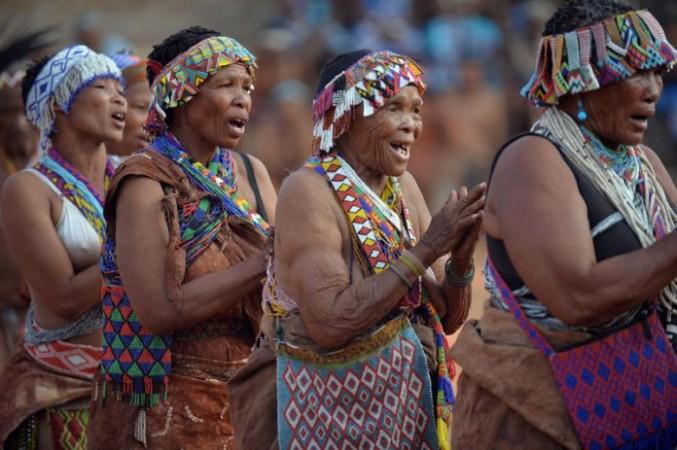
Participate in traditional Kuru Dance - © Sunday Standard
Weather in Ghanzi: Best Time to Visit
Ghanzi is located in the Kalahari Desert, which gives it a semi-arid climate characterized by hot summers and colder winters. The region experiences distinct dry and rainy seasons, making it essential for travelers to plan their visit accordingly.
Summer in Ghanzi
Summers in Ghanzi are typically hot, with temperatures ranging from 30°C to 40°C (86°F to 104°F) during the day. The rainy season occurs during these months, though rainfall is sporadic and tends to come in short, heavy downpours. However, summer rains bring life to the desert, and the Kalahari turns lush and green, attracting a diverse range of fauna. For travelers looking to experience Ghanzi’s natural beauty, this is a great time to visit, but it's important to stay hydrated and protect against the heat.
Winter in Ghanzi
Winter in Ghanzi is much cooler, with daytime temperatures averaging between 15°C and 25°C (59°F to 77°F), though nights can get quite chilly, sometimes dropping below 5°C (41°F). This dry season offers clear skies and pleasant weather for outdoor activities such as safari tours and hiking. Since the temperatures are milder, winter is considered one of the best times to explore Ghanzi, especially for those who prefer cooler climates. However, it’s essential to pack warm clothing for the evenings.

Witness Ghanzi's wildlife in Kalahari Desert Safaris - © Leon Pauleikhoff
Essential Travel Information
Getting around Ghanzi
- By Car: Renting a car is the most convenient method to see Ghanzi and its expansive desert vistas. The main roads are well-maintained, and 4x4 vehicles are recommended for off-road adventures, especially if you plan to visit remote San villages or explore the Central Kalahari Game Reserve.
- Public Transport: Public transport within Ghanzi is limited, and while there are buses connecting Ghanzi to larger cities like Gaborone and Maun, they are less frequent and not ideal for local travel. Within town, taxis are available, but these are mostly used for short trips rather than long-distance travel.
- Guided Tours: For those looking to experience Ghanzi’s natural and cultural attractions without the hassle of driving, guided tours are a popular option. Local tour operators offer a range of services, from cultural tours of San communities to wildlife safaris in the Kalahari.
ATM & Banking Services
Ghanzi offers basic banking services, including a few ATMs in town where visitors can withdraw cash. However, due to the town's remote location, it's wise to carry enough cash, especially if traveling to more isolated areas, as ATMs can occasionally run out of funds during peak seasons. While most lodges, restaurants, and larger businesses accept credit cards, it's a good idea to have some local currency on hand for smaller purchases or when visiting markets.
Where to Stay in Ghanzi
- Luxury Lodges: For a more upscale experience, luxury lodges provide spacious accommodations with modern amenities and stunning views of the Kalahari landscape. These lodges are typically located on the outskirts of town, offering convenient access to local wildlife reserves and cultural tours.
- Mid-Range Guesthouses: These accommodations are usually family-run and provide a comfortable base for exploring the town and its surroundings. Many guesthouses include breakfast and are well-suited for travelers seeking a balance between comfort and affordability.
- Safari Camps: For those looking to immerse themselves in nature, camping sites and eco-lodges offer a more rustic experience. Located near the desert, these options provide an authentic wilderness experience and focus on minimal environmental impact.
Articles for you

Explore Yala National Park - Sri Lanka Travel, Asia
Tucked away in Sri Lanka’s southeastern corner, Yala National Park is where wild nature meets deep tradition. Known worldwide for its leopard population, the park is also home to elephants, sloth bears, crocodiles, and hundreds of bird species. Beyond wildlife, Yala opens doors to a cultural landscape dotted with ancient temples, Buddhist ruins, and coastal villages. For travelers seeking more than just a safari, Yala offers a chance to explore eco-tourism, local communities, and sacred heritage sites.
Population: The Yala National Park area doesn’t have a human population.
Economy: The economy around Yala National Park thrives on a blend of eco-tourism, agriculture, and local services. Safari tours, eco-lodges, and cultural experiences drive steady income for nearby towns like Tissamaharama and Kataragama, supporting thousands of families.
Landmarks: Famous for Block I of Yala and wildlife encounters, including elephants, sloth bears, crocodiles, and exotic bird species.

Explore Galle - Sri Lanka Travel, Asia
Nestled on Sri Lanka’s southern coastline, Galle is a vibrant city where history meets the sea. Its cobbled streets, colonial architecture, and serene beaches make it a must-visit destination for travelers seeking a blend of culture, adventure, and relaxation. A UNESCO World Heritage site, Galle captivates visitors with its Dutch Fort, bustling markets, and friendly locals. Whether you’re exploring the ramparts at sunset or savoring fresh seafood by the shore, Galle promises an unforgettable journey into Sri Lanka’s heritage.
Population: Approximately 113,000 in 2023.
Economy: Galle’s economy thrives on tourism, trade, and fisheries. The city’s historic fort, colonial architecture, and coastal charm draw thousands of international visitors each year, making tourism its main economic driver. Fishing remains vital for local livelihoods, supplying fresh seafood across the region.
Landmarks: Famous for the Galle Fort, Dutch Reformed Church & Maritime Museum, and Unawatuna Beach.

Explore Bentota - Sri Lanka Travel, Asia
Nestled along Sri Lanka’s southwestern coast, Bentota is a tropical paradise that blends golden beaches, vibrant culture, and thrilling adventures. Famous for its calm waters, luxury resorts, and scenic river estuary, Bentota has become a top destination for travelers seeking both relaxation and authentic experiences. From serene beach walks at sunrise to adrenaline-pumping water sports, this coastal town offers a perfect balance of leisure and exploration. With its proximity to Colombo and Galle, Bentota is easy to reach, making it an ideal stop for both short escapes and extended holidays.
Population: Approximately 37,000 in 2023.
Economy: Bentota’s economy thrives mainly on tourism, which drives local businesses such as hotels, restaurants, and wellness retreats. The town also benefits from fishing, coconut cultivation, and handicrafts like wood carving and batik textiles. Many residents rely on the growing demand for water sports and Ayurvedic treatments, making tourism the backbone of both income and employment in the area.
Landmarks: Famous for Bentota Beach, Bentota River Safari, and Kande Vihara Temple.

Explore Mirissa - Sri Lanka Travel, Asia
Mirissa is a charming coastal town on Sri Lanka’s southern shoreline. Known for its golden beaches, turquoise waters, and vibrant marine life, it has become a must-visit stop for travelers exploring the island. Many come for whale watching, surfing, and sunset views at Coconut Tree Hill, but Mirissa offers much more than postcard beauty. The fishing boats you see anchored by the bay carry generations of stories. Local traditions, delicious cuisine, and a laid-back rhythm of life shape every visitor’s experience.
Population: Approximately 4,700 in 2023.
Economy: Mirissa’s economy is largely shaped by its coastal location. Fishing has long been the backbone of local livelihoods, with generations relying on the Indian Ocean for income. In recent decades, tourism has become the main driver of growth, thanks to whale watching, surfing, and beachside hospitality.
Landmarks: Famous for Mirissa Beach, Coconut Tree Hill, and Parrot Rock Bridge.

Explore Nuwara Eliya - Sri Lanka Travel, Asia
Tucked away in the Central Highlands of Sri Lanka, Nuwara Eliya is often called “Little England”. With its rolling tea plantations, cool misty mornings, and colonial charm, this mountain town feels like a step into another world. Travelers come here to breathe fresh air, walk through flower gardens, sip the finest Ceylon Tea, and enjoy a pace of life far from the island’s busy cities. Whether you’re drawn by scenic landscapes, heritage architecture, or the warmth of its people, Nuwara Eliya is a destination that blends nature, culture, and history in perfect harmony.
Population: Approximately 781,000 in 2023.
Economy: Nuwara Eliya’s economy thrives mainly on tea production, as it sits in the heart of Sri Lanka’s central highlands, famous worldwide for Ceylon Tea. The city also benefits from a growing tourism industry, attracting visitors with its colonial charm, cool climate, and scenic landscapes.
Landmarks: Famous for Gregory Lake, Hakgala Botanical Garden, and Victoria Park.

Explore Sukau - Malaysia Travel, Asia
Nestled on the banks of the Kinabatangan River in Sabah, Malaysian Borneo, Sukau is a destination where wildlife, culture, and conservation come together. Known as one of Asia’s top spots for river safaris and eco-tourism, this quiet village offers a front-row seat to encounters with Bornean orangutans, pygmy elephants, proboscis monkeys, and exotic birdlife.
Population: Approximately 1,400 in 2019.
Economy: Sukau’s economy is shaped by its riverine location and natural resources. Traditionally, the Orang Sungai community relied on fishing, small-scale farming, and forest gathering for their livelihood. Today, the village has shifted toward eco-tourism, with river cruises, jungle trekking, and homestays providing income.
Landmarks: Famous for the Kinabatangan River cruises, Gomantong Caves, and Ox-bow lakes and wetlands.
